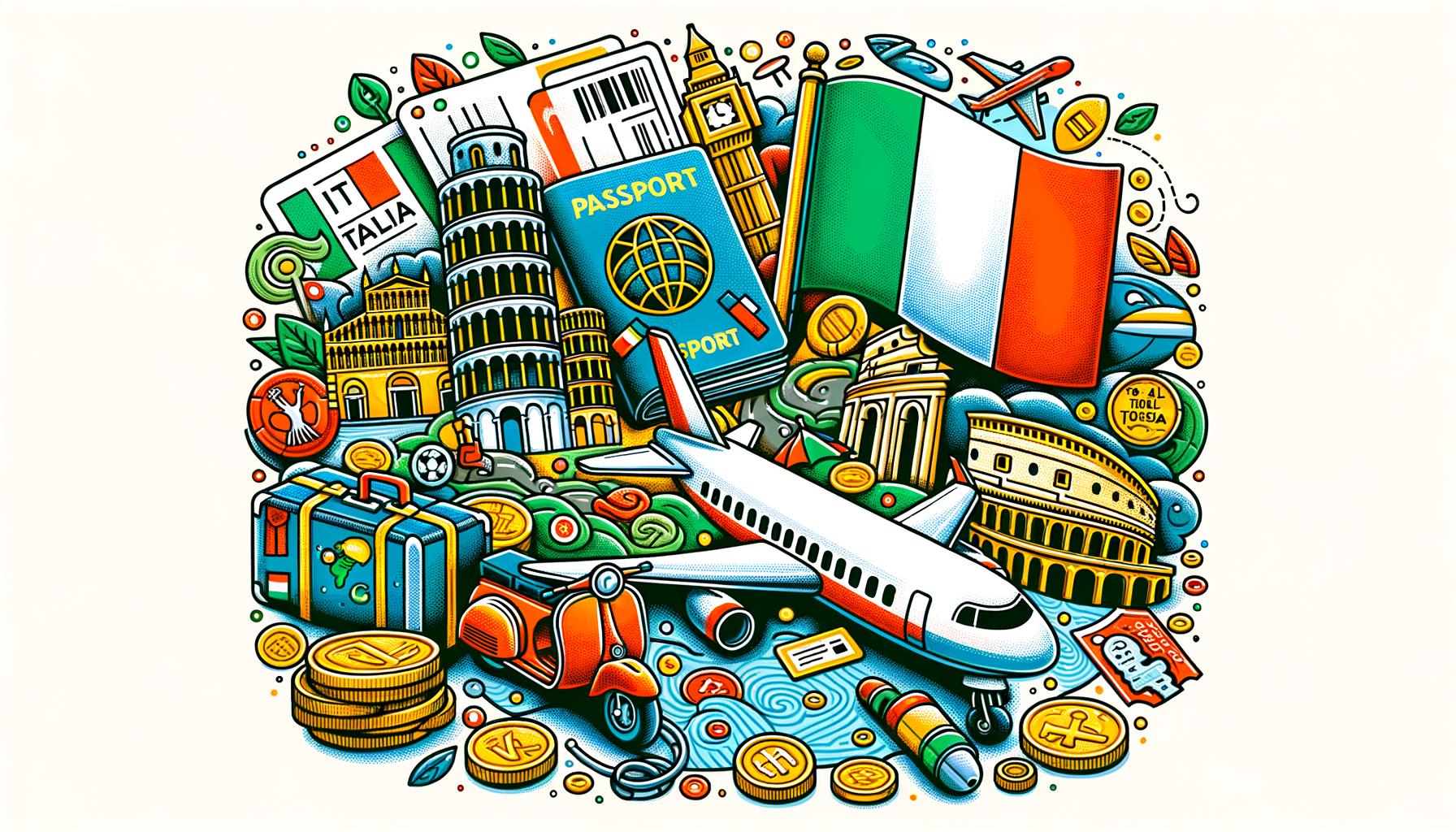Are you planning a trip to Italy and wondering how much a travel visa will cost you? Travel visas are essential documents that allow individuals to enter a foreign country for a specific period.
In this article, we will explore the cost of obtaining a travel visa to Italy, as well as the different types of visas available and the application process. Whether you are traveling for leisure, work, or study, understanding the purpose of a travel visa is crucial in planning your trip.
Italy offers various types of travel visas depending on the purpose of your visit. It’s essential to know which type of visa you need before applying. The cost of a travel visa to Italy can vary depending on several factors, including the type of visa, duration of stay, and any additional fees. We will delve into these factors in detail and provide tips on how to save money on your travel visa to Italy.
In addition to the basic cost of a travel visa, there may be additional fees and expenses associated with the application process. It’s important to be aware of these potential extra costs so that you can budget accordingly.
Furthermore, certain factors such as rush processing or using a third-party agency can affect the overall cost of obtaining a travel visa to Italy. In the following sections, we will discuss these factors in depth and provide guidance on navigating through them.
Types of Travel Visas for Italy
When planning a trip to Italy, one of the essential things to consider is obtaining the right travel visa for your stay. There are several types of travel visas available for Italy, each with its own specific requirements and purposes.
Types of Travel Visas
There are different types of travel visas for Italy, including:
- Short-stay Visa (Schengen Visa): This type of visa allows travelers to visit Italy and other Schengen area countries for up to 90 days within a 180-day period. It is suitable for tourism, business, or visiting family and friends.
- Long-stay Visa (National Visa): This visa is intended for individuals planning to stay in Italy for more than 90 days, such as students, employees, or individuals seeking residency.
- Transit Visa: For travelers passing through Italy en route to another destination outside the Schengen Area.
Each type of visa has its own specific requirements regarding documentation, purpose of visit, and duration of stay. It’s important to determine which type of visa is appropriate for your planned activities in Italy.
The application process and fees may vary depending on the type of visa you need. Understanding the differences between these visas will help you navigate through the application process and ensure that you apply for the correct visa based on your travel plans.
It’s important to research and determine early on which type of visa best suits your needs in order to ensure a smooth and successful application process. Knowing how much is a travel visa to Italy can also help you budget accordingly and avoid any unexpected financial strain during your trip planning.
Application Process for a Travel Visa to Italy
The application process for a travel visa to Italy can be a bit daunting, but with the right information and preparation, it can be a smooth experience. The first step in the process is to determine which type of visa you need for your trip to Italy. As mentioned in the previous section, there are different types of travel visas for Italy depending on the purpose of your visit, such as tourism, business, or family visits.
Once you have determined the type of visa you need, you will need to gather all the necessary documentation for your application. This may include a completed visa application form, a valid passport, passport-sized photos, proof of accommodation in Italy, proof of sufficient funds to cover your stay, travel itinerary, and proof of travel insurance.
It is important to carefully review the requirements for your specific type of visa to ensure that you have all the necessary documents before submitting your application.
After gathering all the required documents, you can then proceed with submitting your visa application. Depending on your location, you may need to schedule an appointment at the Italian consulate or embassy in your country. It is important to note that there is a non-refundable fee for submitting a visa application.
This fee varies depending on the type of visa and can range from approximately $35 to $150. Additional fees may also apply for certain types of visas or expedited processing. It’s important to research and budget for these costs when planning your trip.
Overall, knowing how much is a travel visa to Italy requires careful consideration and planning ahead of time. By understanding the application process and being prepared with all necessary documentation, you can navigate the process smoothly and efficiently while ensuring that you have budgeted appropriately for any associated costs.
Cost of a Travel Visa to Italy
The cost of a travel visa to Italy can vary depending on several factors. It’s important to understand the different fees and expenses associated with obtaining a travel visa to ensure that you are prepared for the financial commitment.
When applying for a travel visa to Italy, you will need to consider the following costs:
- Visa application fee
- Service fees (if using a visa processing agency)
- Courier fees (if applicable)
The visa application fee for Italy can range from $50 to $100, depending on the type of visa you are applying for and your nationality. Additionally, if you choose to use a visa processing agency to assist with your application, you may incur service fees ranging from $30 to $100. Some applicants also opt for courier services to have their documents delivered, which can cost an additional $20-50.
It’s important to budget for these expenses when planning your trip to Italy and factor in any additional fees that may arise during the application process. Keep in mind that these costs are in addition to any other travel expenses such as airfare, accommodations, and daily spending. If you’re wondering how much is a travel visa to Italy, it’s essential to consider all potential fees and expenses involved in the application process.
Additional Fees and Expenses
When planning a trip to Italy, it’s important to consider the additional fees and expenses that come with obtaining a travel visa. In addition to the cost of the visa itself, travelers may also need to budget for other expenses such as application fees, processing fees, and any required documentation or medical exams.
In general, the cost of a travel visa to Italy can vary depending on the type of visa being applied for and the traveler’s nationality. For example, as of 2021, the application fee for a Schengen short-stay visa (up to 90 days) is €80 for adults and €40 for children aged 6-12. However, certain categories of individuals may be eligible for reduced or waived fees, such as students, researchers, or family members of EU/EEA citizens.
Another factor to consider when budgeting for a travel visa to Italy is the cost of any additional services that may be required during the application process. For example, travelers may need to pay for express processing or courier services in order to expedite their visa application. Additionally, some travelers may need to provide additional documentation such as travel insurance or proof of accommodation, which can also incur extra costs.
| Travel Visa Type | Cost |
|---|---|
| Schengen Short-Stay Visa (up to 90 days) | €80 for adults; €40 for children aged 6-12 |
| Express Processing | Varies |
| Courier Services | Varies |
Overall, it’s important for travelers to carefully research and budget for all potential costs associated with obtaining a travel visa to Italy in order to avoid any unexpected expenses. By understanding the full scope of additional fees and expenses, travelers can better prepare financially for their trip and ensure a smooth visa application process.
Factors That Affect the Cost of a Travel Visa to Italy
Duration of Stay
The length of time you plan to stay in Italy can greatly impact the cost of your travel visa. Typically, longer stays require more extensive visas, which can result in higher fees. It’s important to carefully consider and plan your trip duration in order to accurately budget for the associated visa costs.
Urgency of Application
If you require expedited processing for your travel visa to Italy, you may incur additional fees. It’s important to factor in any urgent processing needs when budgeting for your travel expenses, as this can significantly impact the overall cost of your visa.
Applicable Exchange Rates
When calculating the cost of a travel visa to Italy, it’s crucial to consider any applicable exchange rates. Depending on the current exchange rate between your home country’s currency and the Euro, the cost of your visa may fluctuate. Be sure to stay updated on exchange rates in order to accurately estimate the total cost of obtaining a travel visa to Italy.
Considering these factors can help travelers better understand how much is a travel visa to Italy and adequately prepare for any associated expenses. By carefully assessing these variables, individuals can plan and budget for their trip with greater accuracy and confidence.
Tips for Saving Money on a Travel Visa to Italy
Traveling to Italy can be an exciting and enriching experience, but the cost of obtaining a travel visa can be a deterrent for many travelers. Fortunately, there are ways to save money on your travel visa to Italy without compromising the quality of your trip. By following these tips, you can make the visa application process more affordable and stress-free.
Plan Ahead and Apply Early
One of the simplest ways to save money on a travel visa to Italy is to plan ahead and apply early. Rush processing fees can add up quickly, so it’s best to give yourself plenty of time to gather all necessary documents and submit your application well in advance of your intended travel date. This will also allow you to take advantage of any available discounts or promotions that may be offered by the Italian consulate or embassy.
Choose the Right Type of Visa
When applying for a travel visa to Italy, it’s important to choose the right type of visa for your specific needs. For example, if you are only planning a short visit for tourism purposes, you may be eligible for a Schengen visa which allows you to travel within the Schengen area, including Italy. Applying for the appropriate type of visa can help you avoid unnecessary expenses associated with more comprehensive visas.
Be Mindful of Additional Fees
In addition to the cost of the visa itself, there may be additional fees and expenses associated with the application process. This could include fees for document legalization, postage, or biometric data collection. To save money on these additional expenses, carefully review all requirements and instructions provided by the Italian consulate or embassy and ensure that all necessary documentation is complete and accurate before submitting your application.
By following these tips for saving money on a travel visa to Italy, you can make your dream trip a reality without breaking the bank. Remember that careful planning and attention to detail can go a long way in reducing unnecessary expenses and ensuring that you have a smooth and affordable visa application process.
Conclusion
In conclusion, the cost of a travel visa to Italy is an important consideration for anyone planning a trip to this beautiful country. While the actual price of the visa may vary depending on factors such as the type of visa, additional fees, and currency exchange rates, it is essential to budget for this expense when planning your trip.
Understanding the purpose of a travel visa and the application process can help travelers determine if obtaining a visa is worth the cost.
When considering whether getting a travel visa to Italy is worth the cost, it’s important to take into account the benefits of visiting this stunning destination. From exploring historic cities like Rome and Florence to enjoying world-renowned cuisine and breathtaking landscapes, Italy offers an unforgettable experience for travelers.
The cultural and historical richness of Italy makes it a popular choice for tourists from around the world, making the process of obtaining a travel visa well worth it for many.
Ultimately, while there may be expenses associated with obtaining a travel visa to Italy, the value of experiencing everything this remarkable country has to offer often outweighs these costs. For those who are seeking ways to save money on their travel visas, it’s advisable to research different types of visas, plan ahead, and be mindful of any additional fees or expenses that may arise during the application process.
With proper preparation and understanding of the costs involved, getting a travel visa to Italy can be a worthwhile investment for an unforgettable journey.
Frequently Asked Questions
Is Italy Visa Free for US Citizens?
Italy is not visa-free for US citizens. American citizens need to obtain a visa before traveling to Italy, whether it is for tourism, business, or any other purpose.
How Long Does It Take to Get a Travel Visa Italy?
The processing time for a travel visa to Italy can vary depending on the type of visa you are applying for and the workload of the Italian consulate or embassy. It is advisable to start the application process well in advance of your planned travel dates to allow for any potential delays.
How Do I Get a Tourist Visa for Italy From USA?
To get a tourist visa for Italy from the USA, you will need to apply through the Italian consulate or embassy that has jurisdiction over your place of residence. The application process typically involves completing a visa application form, providing necessary documentation (such as passport, itinerary, proof of accommodation and financial means), scheduling an appointment for an interview if required, and paying the applicable fee.
It is recommended to check the specific requirements of the consulate or embassy where you will be applying as they may vary slightly.

I’m a passionate traveler, writer, and Italophile. My fascination with Italy’s history, art, and culture has led me on countless adventures across the Italian landscape. Through “I Live Italy,” I share my love for this extraordinary country and aims to inspire others to explore its boundless beauty.





